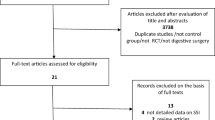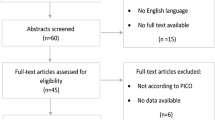Abstract
Purpose
The study was designed to assess the difference in microbiological colonisation and growth that may occur in drains, in the setting of clean-contaminated compared to clean head and neck surgery.
Methods
A prospective observational cohort study was performed. Surgical drain tips upon removal were sent for bacterial culture and the culture results were compared between clean-contaminated and clean procedures using mixed effects logistic regression. In all statistical analyses, a priori, p < 0.05 (two-tailed) was calculated to indicate statistical significance.
Results
One hundred and ten drains were examined in both clean-contaminated and clean procedures. Drains from clean-contaminated procedures had a significantly longer time in situ (11 vs 5 days, p < 0.001). Overall, significant evidence was seen for an association between procedure type and drain growth rates: 68% of clean-contaminated procedures; and 45% of clean procedures. Although not statistically significant, there was an increase in normal skin flora contaminated drains in clean-contaminated procedures (41 vs 25%). Rates of pathogenic skin organisms (15 vs 16%) and pathogenic oropharyngeal organisms (2.9 vs 0%) were similar for clean-contaminated vs clean procedure patients.
Conclusion
This preliminary study demonstrated a higher rate of microbial contamination of neck drains that were placed during procedures that involved continuity with the upper aero-digestive tract and neck. Retrograde migration of skin flora along the drain is common but of no clinical significance. Similar rates of pathogenic microbial growth have been demonstrated thus far. However, selection of nosocomial pathogens due to extended antibiotic prophylaxis may pose a risk for infection.
Level of evidence
1b.


Similar content being viewed by others
References
Amir I, Morar P, Belloso A (2010) Postoperative drainage in head and neck surgery. Ann R Coll Surg Engl 92:651–654
Memon MA, Memon MI, Donohue JH (2001) Abdominal drains: a brief historical review. Ir Med J 94:164–166
Horan TC, Gaynes RP, Martone WJ, Jarvis WR, Emori TG (1992) CDC definitions of nosocomial surgical site infections: a modification of CDC definitions of surgical wound infections. Infect Control Hosp Epidemiol 13:606–608
Cruse PJ, Foord R (1973) A five-year prospective study of 23,649 surgical wounds. Arch Surg 107:206–210
Mangram AJ, Horan TC, Pearson ML, Silver LC, Jarvis WR (1999) Guideline for prevention of surgical site infection, Hospital Infection Control Practices Advisory Committee. Infect Control Hosp Epidemiol 20:250–278
Yates JL (1955) An experimental study of the local effects of peritoneal drainage. Am Surg 21:1048–1072
Dougherty SH, Simmons RL (1992) The biology and practice of surgical drains. Part 1. Curr Probl Surg 29:559–623
Langerman A, Thisted R, Hohmann S, Howell M (2016) Antibiotic and duration of perioperative prophylaxis predicts surgical site infection in head and neck surgery. Otolaryngol Head Neck Surg 154:1054–1063
Reiffel AJ, Barie PS, Spector JA (2013) A multi-disciplinary review of the potential association between closed-suction drains and surgical site infection. Surg Infect (Larchmt) 14:244–269
Harris T, Doolarkhan Z, Fagan JJ (2011) Timing of removal of neck drains following head and neck surgery. Ear Nose Throat J 90:186–189
Becker GD, Parrell GJ (1979) Cefazolin prophylaxis in head and neck cancer surgery. Ann Otol Rhinol Laryngol 88:183, 1979
Murphy J, Isaiab A, Dyalram D, Lubek J (2017) Surgical site infections in patients receiving osteomyocutaneous free flaps to the head and neck. Does choice of antibiotic prophylaxis matter? J Oral Maxillofac Surg 75:2223–2229
Cohen ME, Salmasian H, Liu J, Zachariah P, Wright JD, Freedberg DE (2017) Surgical antibiotic prophylaxis and risk for postoperative antibiotic-resistant infections. J Am Coll Surg 225(5):631–638
Author information
Authors and Affiliations
Corresponding author
Ethics declarations
Conflict of interest
The authors have no funding, financial relationships or conflicts of interest to disclose.
Rights and permissions
About this article
Cite this article
Seneviratne, S., Hoffman, G., Varadhan, H. et al. Does microbial colonisation of a neck drain predispose to surgical site infection: clean vs clean-contaminated procedures. Eur Arch Otorhinolaryngol 275, 1249–1255 (2018). https://doi.org/10.1007/s00405-018-4921-8
Received:
Accepted:
Published:
Issue Date:
DOI: https://doi.org/10.1007/s00405-018-4921-8




